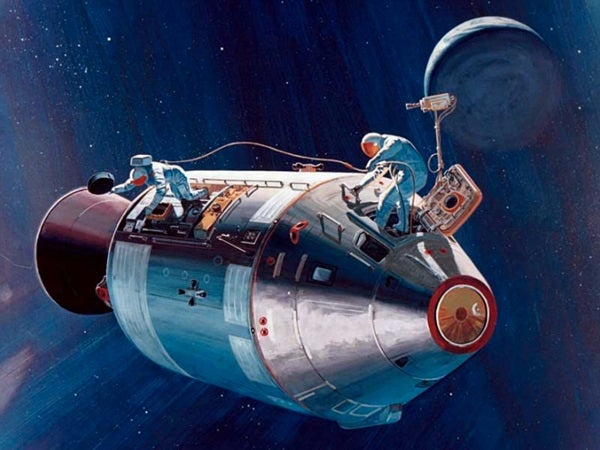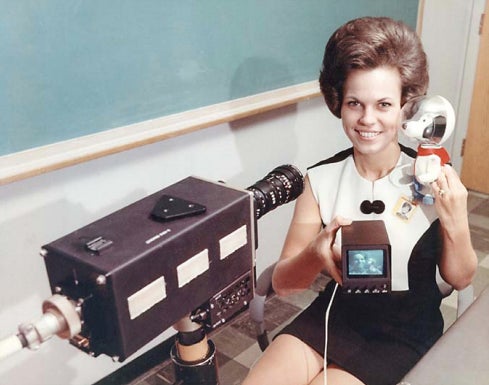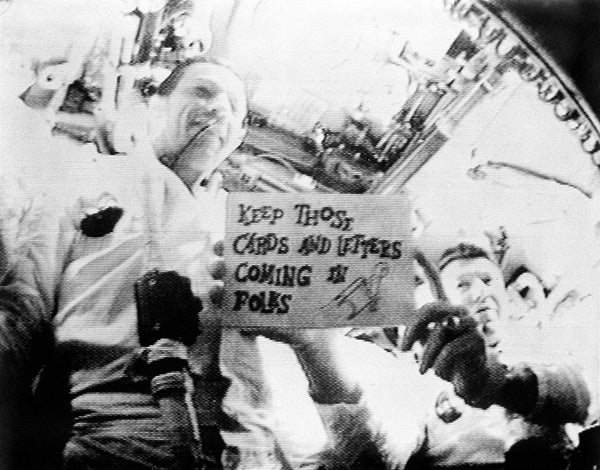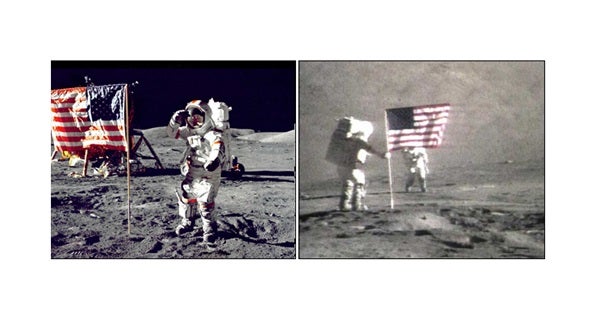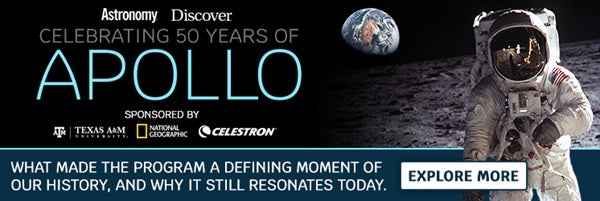It seems only natural that we have video footage of man’s first steps on the Moon — after all, television had become popular in America more than a decade before Apollo 11’s famous broadcast. But a television audience was not a guaranteed passenger on the journey to the lunar surface. Arguments abounded over whether a television camera was truly mission critical — after all, the mission’s objectives could be met without it. Plus, broadcasting from the Moon would pose significant technical challenges.
But a live video signal would not only allow mission controllers a real-time view of the astronauts’ activities, it would also allow the American public — who had funded the program through taxpayer dollars — to come along for the ride. Television was, as Apollo 7 Lunar Module Pilot Walt Cunningham told Astronomy, “their chance to share in what was going on with the Apollo program.”
Meeting mission requirements
During Apollo’s development, broadcast television cameras were too large, too heavy, and far too power-hungry to feasibly operate in a spacecraft or bring to the lunar surface. A camera capable of transmitting from the Apollo spacecraft and, ultimately, the Moon needed unique and challenging specs: it must be lightweight (6 pounds [2.7 kilograms] or less), consume low power (6 watts), and maintain function within a wide range of temperatures (–250 to +250 degrees Fahrenheit [–157 to 121 degrees Celsius]). And it must be capable of low-light function, have automatic light control, and operate automatically without external control.
NASA turned to the RCA Corporation — a well-known electronics company — to develop a television camera for use on the Command/Service Module (CSM), the main spacecraft that would carry the astronauts to and from the Moon. The Westinghouse Electric Corporation, known for its innovation in the fields of lighting, radio transmission and energy generation, won the contract to make the camera for use during lunar landings. RCA’s camera was ready first, and began its tour of service with the first manned Apollo mission: Apollo 7. The Westinghouse camera first flew on Apollo 9.
Not enough bandwidth
At the time, standard American television signals transmitted 30 frames per second, using 4–5 MHz of bandwidth. But the Apollo transmission system, called Unified S-Band or USB, needed to use their limited bandwidth to transmit all the other data from the spacecraft, including vital voice and navigational data, too. This system left only about 500 kHz for television communications — a fraction of what was normally needed.
So to make the TV signal small enough to send back to Earth, NASA altered its format and shot only 10 frames per second. Though the picture was lower quality, it took up less data on its way back to Earth.
TV compatibility
But these changes meant the signal received at home wasn’t compatible with earthly TV sets. So NASA’s Goddard Space Flight Center and RCA teamed up to create a conversion system: They pointed a video camera, an RCA model TK-22, at a small screen showing the live footage from Apollo.
But the difference in frame speeds — Apollo’s transmission of 10 frames per second, compared to normal TV’s 30 — caused a problem called “image overlap.” Since the frames changed at different rates, the TK-22 would sometimes output two subsequent Apollo frames overlapped.
To avoid this problem, RCA modified their conversion device using a system used for slow-motion playback during sporting event broadcasts. This would replay the same Apollo frame several times in front of the TK-22 camera, allowing it to capture the video properly. Although the picture quality was unavoidably degraded from the original, it allowed the American public to experience Apollo firsthand on their home television sets.
Live from the Apollo
Along with the rest of the Apollo data, television signals were transmitted from the spacecraft such that anywhere on the Moon-facing side of Earth could have received the data. But very few places on Earth were set up to receive the signal.
As with any transmission from space, the received signal strength is diminished by the square of the distance traveled. Plus, there’s solar system background noise, and interference caused by the signal passing through Earth’s atmosphere. That’s why NASA has a global network of tracking stations with huge antennas — monstrous satellite dishes over 200 feet (60 meters) in diameter — that they use to pick up these signals.
The first live video from space was broadcast from Apollo 7’s black-and-white RCA camera. It was picked up by NASA tracking stations in Corpus Christi, Texas and Merritt Island, Florida, converted for TV viewing, and finally sent to Houston where it was broadcast to the public.
“We gave them displays of the spacecraft, and of us moving around, and things like that,” Cunningham says. “It was not very good television, and the TV camera itself, you wouldn’t even want to believe it, it was such a crude kind of television camera — but for some non-professionals like us doing television, it was okay. But I don’t think the public saw it the same way as we did.” Instead, he says, they saw it as a way to participate in Apollo, even from home. “The public enjoyed it,” he says.
But use of the cameras was secondary to Apollo’s main mission goals. The TV systems were tested, and signals broadcast, only once other tasks had been completed and success assured. “It was just another thing to do. It was in the flight plan that we wanted to check out the TV camera, make sure it worked when we got to the Moon,” says Jim McDivitt, commander on Apollo 9.
Now in color
Apollo 10 transmitted the first color television signal from the CSM, filming everything from the docking procedure to connect the LM and CSM to the surface of the Moon from lunar orbit. The mission also included the first camera “viewfinder” for the astronauts — a small black-and-white television monitor, comprised largely of off-the-shelf components, featuring a 2 by 2.75-inch (5 by 7 cm) screen.
The Apollo color camera was not state of the art in its design — in fact, it was based on a camera first developed in 1940 by CBS, called a color-wheel camera. As its name implies, a color-wheel camera includes a spinning filter wheel behind the lens, which captures separate images in red, green, and blue through filters. Back on earth, these separate images were combined into one full-color image.
This camera was chosen for its low weight and power consumption, but its signal didn’t mesh with the standard format of American color TV, NTSC color. So the television signals were sent from the tracking stations to NASA’s Mission Control Center in Houston in black and white, where the final color conversion was made for public broadcast in NTSC format.
TV from the Moon
Even though the CSM was equipped with a color camera at the time, Apollo 11’s transmissions from the Moon were in black-and-white. In an interview with TVTechnology.com, NASA employee Dick Nafzger said the black-and-white format was used during the first lunar landing to ensure good signal to noise — in other words, it increased the chances that the tracking stations could lock on to the signal and relay the best possible image. So Neil and Buzz were recorded in black and white on the surface, while color TV was transmitted from the CSM. It wasn’t until after the success of Apollo 11’s TV transmissions, Nafzger said, that NASA felt confident that color TV, which requires larger bandwidth, could be sent from the Moon.
Apollo 11’s initial lunar TV transmissions were recorded with the camera mounted on the LM’s descent stage. As he exited the LM’s hatch, Armstrong pulled a lanyard to expose the camera and Aldrin powered it on from the cockpit to capture the historic first steps. The signals were sent via the LM’s antenna to NASA tracking stations in Goldstone, California and Canberra, Australia, and also to the Parkes radio telescope in New South Wales, Australia. The latter, with its nearly 210-foot (64 m) diameter dish, provided the highest-quality signal of the three and was used as the main source of the first broadcast.
After those famous first steps, the camera was moved from the LM to a stand to record both astronauts at work. It remained attached to the LM via a power cable, but that power would abruptly cut off at the end of the EVA when the ascent stage launched. Later missions, however, would carry the additional equipment necessary to continue recording and transmitting after power from the LM to the camera had been severed.
Though that first TV broadcast from the Moon had its hitches, overall it was a resounding success. The carefully wrought technology designed for the harsh lunar landscape performed admirably, bringing the world together on this historic mission and creating a live window as men stepped out into the previously unknown.

